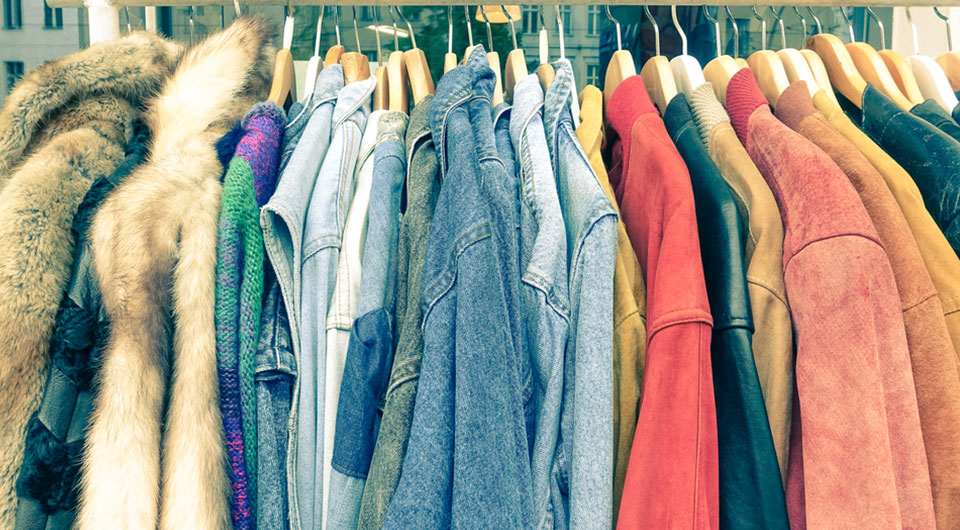Looking for some tips on selling clothing second-hand? Well, the first step is to conduct a closet clean out and bid adieu to clothing items you don’t need. Now, it’s time to get the bags out of the house before you decide to unpack them again. Sure, donating clothing to Goodwill or dropping them off at a nearby Levi’s store can be a quick and painless option. But if you have the time, energy, and interest, you might just be able to squeeze some extra cash out of your hand-me-downs and cast-offs.
But, there are a few tricks to this trade, so when it comes to re-selling clothing to second-hand stores such as Buffalo Exchange or Crossroads Trading Co., it’s worth doing your research (or letting us do it for you). Read on for pro tips, and good luck!
1. Be selective on what you bring to the store.
Pre-sorting your items before you go to the store is an important first step. The buyer going through your potential merchandise does not want to sort through multiple trash bags hunting for rare finds. Plus, walking out with the same large trash bags you walked in with is not good for your ego. Just bring what you think has a chance of selling. How do you know what items are gems? Keep on reading…
2. Presentation Matters
Speaking of trash bags, opt for toting in your clothes in a canvas bag or backpack. Make sure all clothing is clean, does not smell, and that items aren’t turned inside out, so that the buyer can asses things as quickly as possible. If sold, a lot of clothing will go straight on to the retail floor, so your chances might improve with a quick iron of particularly crumpled or scrunched items.
3. Designer labels do well.
Popular designer brands or classic vintage labels – including Levi’s, of course – have a better chance of selling, but it’s also not a guarantee.
4. Visible wear and tear does not.
Unless you have a rare vintage t-shirt or vintage jeans in which rips and tears have added unique character, items with visible wear and tear are best left in the straight-to-donate pile. Check all items for sweat stains, holes, and fading before offering them on the auction block. The same goes for shoes – worn down soles and heels are an automatic disqualifier for purchase, no matter how cute or trendy the style is.
5. Bring seasonal items.
Buyers are looking to stock clothing for the upcoming fashion season and tend to buy more when their stock is low. Time your visits to second-hand stores at the beginning of each season, rather than the tail end. No one will be buying winter coats in the middle of summer, and, similarly, they’re not looking to buy summer dresses in winter.
6. Opt for trendy or classic.
Just because they are second-hand stores, doesn’t mean they aren’t looking for trendy items. If you don’t want an item anymore because it’s notably out of style, its unlikely that they’ll want to buy it, either.
7. Clean out his closet, too.
Since more women tend to sell clothing, bringing along men’s clothing can increase your chances of selling items, especially since men’s styles don’t vary as much year-to-year.
8. Don’t take rejection personally.
If you’re not successful in selling your items, don’t take it personally. Just treat any successful sales like a bonus for money you never expected to have in the first place. If you do make a sale, don’t be offended by the asking price. A buyer is taking the item at face value, and won’t have the same sentimental connection you inevitably feel toward a favorite sweater or go-to party dress. Detach your memories from the object, and just let go!
9. Be Friendly, But Not Too Friendly
Let your clothes speak for themselves. Chat with the buyer if they initiate conversation, but this is not your chance to channel a used car salesperson and talk up your items. Once they’ve decided whether to take it or not, don’t try to convince them otherwise.
10. Cash or Trade?
Stores vary, but a typical buy/trade rate is 50% store credit of the selling price of your item or 30%-35% in cash. Do not compare these numbers to what you actually bought them for (remember, you also owned them!). Just like cars, the majority of clothes depreciate in value, which is why you can also score good finds in buying from second-hand stores. Be sure to take a look around the store for options of things you may want to buy before deciding to cash out or taking the store credit.
What do you do with clothing that doesn’t sell?
Many stores will accept your clothes and donate them for you, but you can also seek out other options. There’s I:Co, Goodwill, or online companies like Yerdle or Poshmark. And there’s always Craigslist or Ebay – or you can host your own garage sale or clothing swap. Either way, be proud of the fact that you’ve contributed to the circular economy and are doing your part to think more sustainably with your clothing!
Like this story?
Sign up for the Unzipped newsletter to get the best of the Unzipped blog — company news and views, employee profiles, innovation and sustainability stories, behind-the-scenes and Archives highlights — sent straight to your inbox weekly.







